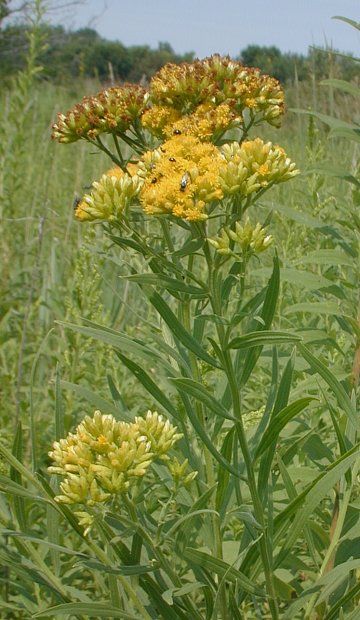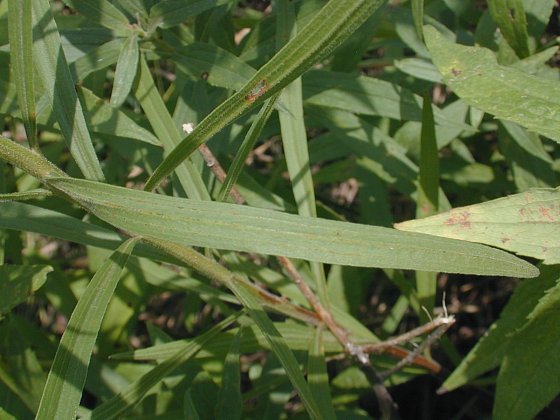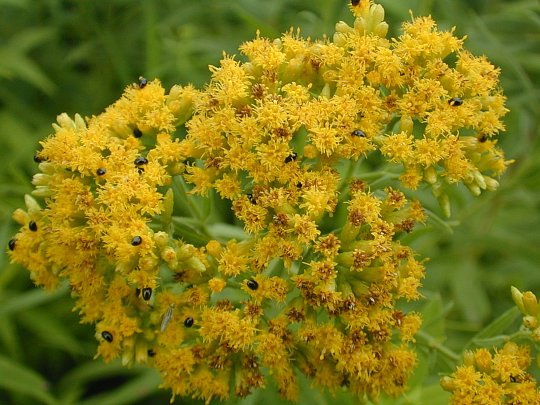Description: This herbaceous perennial plant is 2-3½' tall. Sometimes it is slender and little branched, while at other times it branches frequently, creating a bushy appearance. The slender stems usually have lines of fine white hairs. The alternate leaves are linear and have smooth margins. The larger leaves have 3 conspicuous veins, although the smaller ones usually have only a single conspicuous vein. They are up to 4" long and 3/8" across, or slightly wider. Sometimes there are a few white hairs near the base of the leaves and along the central vein on the underside. There are clusters of small composite flowers at the apex of the plant and many of the upper side stems. These flower clusters are usually rather flat-headed, but they sometimes assume a round-headed appearance. Each composite flower is yellow, consisting of about 21-35 disk florets and ray florets (when considered together). It is only about 1/8" across – smaller than the composite flowers of other goldenrods.

These compound
flowers often bloom gradually, rather than simultaneously, with older
flowers turning brown while younger flowers are still in the bud stage.
The blooming period is late summer to early fall, and lasts about 1
month. Sometimes there is a mild floral scent. The root system is
fibrous, and new plants develop vegetatively from rhizomes. Overall,
Grass-Leaved Goldenrod is rather variable across different localities.
Cultivation:
The preference is full sun and moist conditions. However, this plant
tolerates drier conditions, and can be surprisingly drought tolerant.
The soil should contain high amounts of organic matter; some varieties
of this plant also grow in moist sandy soil. Powdery mildew seems to
bother this goldenrod less often than many others. It is easy to grow,
but can spread aggressively in moist sunny places.

Range &
Habitat:
Grass-Leaved Goldenrod occurs occasionally in most counties of Illinois
(see Distribution
Map), where this plant is native. However, it can be locally
common in some wetlands
areas. Habitats include moist black soil prairies, edges of marshes,
sandy pannes between dunes, calcareous seeps, borders of lakes,
abandoned fields, and ditches along railroads. Grass-Leaved Goldenrod
occasionally occurs in drier habitats, but it has greater trouble
competing with other forbs, such as Solidago canadensis
(Canada Goldenrod), in such places.
Faunal Associations:
The small flowers attract many kinds of insects, including long-tongued
bees, short-tongued bees, wasps, flies, butterflies, moths, and
beetles. Various wasps and a few beetle species, such as Chauliognathus
pennsylvanicus (Goldenrod Soldier Beetle) and Epicauta
pensylvanica (Black Blister Beetle), seem to be especially
attracted to the flowers. Other insects feed destructively on the foliage and other parts of Grass-leaved Goldenrod (Euthamia graminifolia). These insects include leaf beetles, the larvae of gall flies, aphids, the larvae of moths, and Melanoplus femurrubrum (Red-legged Grasshopper); see the Insect Table for a listing of insects that feed on Euthamia spp.
The seeds are eaten by the Eastern Goldfinch and Swamp Sparrow to a
limited extent, while the foliage is occasionally consumed in limited
amounts by the Greater Prairie Chicken, Cottontail Rabbit, and
White-Tailed Deer.

Photographic
Location:
The photographs were taken at Meadowbrook Park in Urbana, Illinois.
Comments:
Grass-Leaved Goldenrod has more slender leaves than other goldenrods in
Illinois, except for Euthamia gymnospermoides (Plains
Grass-Leaved Goldenrod). However, there is only a single conspicuous
vein in the largest leaves of this latter species, its stems are
hairless, it has only 12-20 disk and ray florets in a compound
flower (when considered together), and it is usually more branched and
bushy in appearance. Grass-Leaved Goldenrod also differs from the
latter species by preferring more soggy habitats.